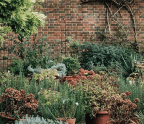
When we grow plants, particularly edible plants, we are manipulating nature. We clear weeds (take away food sources from wild insects and animals), clear around the edges of our plot (take away habitat) and attempt to produce the tastiest, juiciest fruits, leaves and tubers. It’s no wonder that nature wants in. When we change natural environments to grow in a certain way, it can encourage pests and diseases to proliferate. The best treatment is prevention.
Create a garden that is a biodiverse ecosystem and it’s less likely that one type of insect becomes a pest. Create habitats for beneficial predators, such as ponds for frogs and newts, as well as wildflower areas for invertebrates and dead wood piles for hedgehogs. There will always be losses and successes at the hands of nature, but getting to know what you are up against and what nontoxic methods you can use to remedy problems will aid your food-growing success.

Allium leaf miner
These feasters are the larvae of






